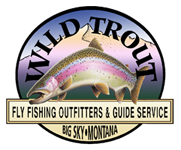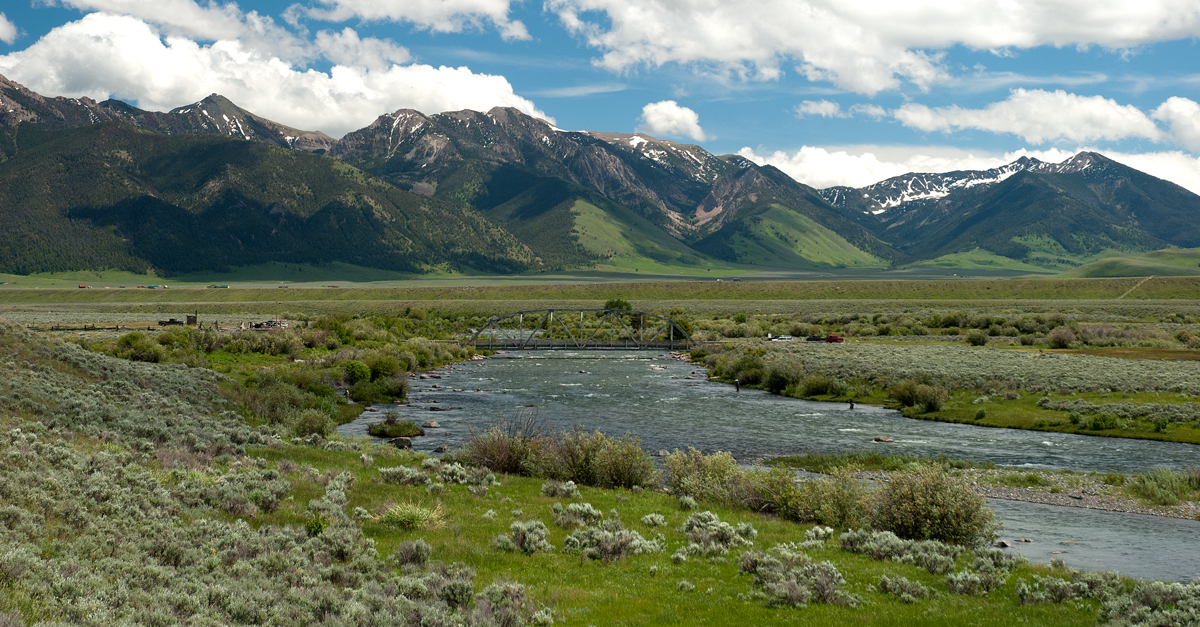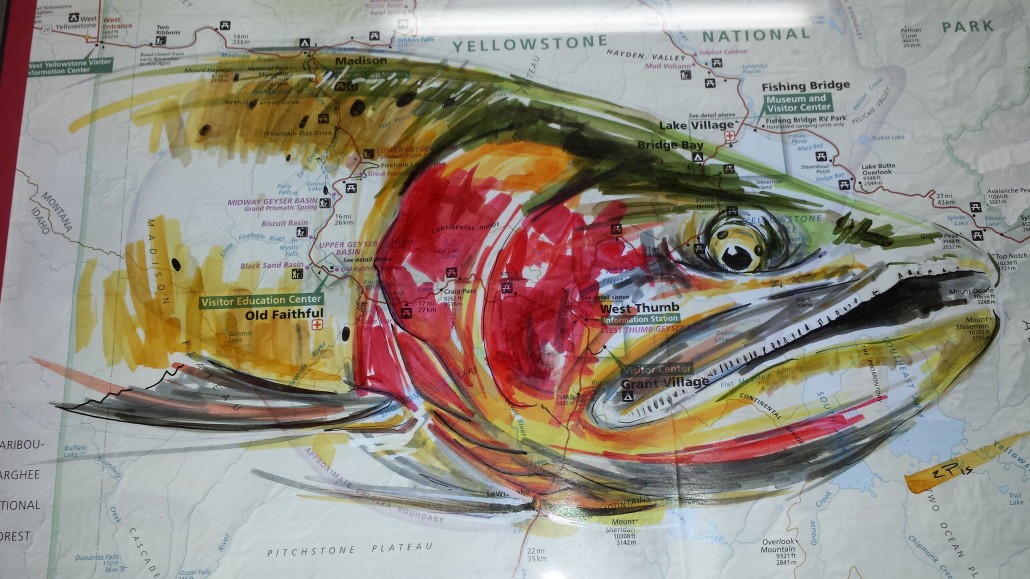GALLATIN RIVER FISHING REPORT
The Gallatin has been dropping like a rock over the past week and is rapidly shaping up. Heavy rain over the past couple of days have temporarily bumped flows up and discolored the river, but we should see improving conditions for the weekend.
Our guides are out on the river daily now and the river has been fishing well. In the span of a week flows have dropped from about 4,000 CFS to just over 2,000 CFS. The river is transitioning from muddy, brown runoff conditions to a very fishable shade of green with a couple feet of visibility. Recent rains have reversed that trend, causing the river to temporarily rise and muddy a bit, but the river should be back on track today and into the weekend. Anglers are excited to get back out on the Gallatin, but keep in mind that at 2,000 CFS the river is still high and powerful – be safe when wading the river.
There have been no reports of salmonfly sightings on the Gallatin yet, but any day now they’ll start popping just below the Gallatin Canyon at river access points such as Axtell Bridge and Williams Bridge. From there the hatch will steadily move up into the canyon, providing anglers with the opportunity to throw giant dry flies to some of the river’s largest trout. The salmonfly hatch is one of those rare occasions when big trout will throw caution to the wind and take flies off of the surface with reckless abandon.
As the river continues to drop and clear over the next couple of weeks we’re going to see a succession of hatches including both salmonflies and their smaller cousins, the golden stonefly. Pale morning duns, yellow sallies, and caddis will all provide additional opportunities to take fish on dry flies over the coming weeks
Until the hatches come off the name of the game will continue to be nymhing. A stonefly pattern such as the venerable Pat’s Rubber Leg is tough to beat as a lead fly, trailed by smaller caddis larva and pupa patterns, PMD imitations, and yellow sally nymphs. Worm patterns will continue to be top producers until flows level out and the river clears.
If you’re interested in having one of our guides show you the best of what the Gallatin has to offer, drop us a line or give us a call (800-423-4742) to book your dream trip and let us do what we do best… put people on fish!
Currently: Large nymphs or dead-drifted streamers in the #4-6 size range such as the Pat’s Rubber Leg, Bitch Creek, Yuk Bug, Mega Prince, San Juan Worm, Bow River Bugger or Sparkle Minnow.
Patterns to stock up on for post-runoff:
Dries: Flutter Bug #6-8, Cat Puke (salmonfly & golden stonefly) #6-10), Rogue Stone (salmonfly and golden stonefly) #6-10, Chubby Chernobyl (Golden) #8-10, Stimulator (Yellow) #10-14, Elk Hair Caddis (Yellow/Tan/Olive) #14-16, X-Caddis (Olive) #14-16, Lime Trude #14-16, Sparkle Dun (PMD) #16-18, Purple Haze #14-18
Nymphs: Pats’ Rubber Legs #8, Mega Prince #8, San Juan Worm (Red) #12, CDC Pheasant Tail #16-18, Pheasant Tail #16-18, Lightning Bug #16-18, Copper John #14-16, Beadhead Yellow Sally #14, CDC Emerger #14-18, Shop Vac #16
Streamers: Sparkle Minnow #4-6, Bow River Bugger #4-6, Home Invader #2-6, McCune’s Sculpin#4, Gonga #4. Be sure to have an array of colors represented in your streamer box including: white, yellow, olive, natural/tan, and black.
UPPER MADISON FISHING REPORT
The upper Madison is in great shape with visibility in the 2-3 foot range from Quake Lake to Ennis Lake. Hatches are imminent and a few salmonflies have already been spotted near Ennis… the hatch will erupt any day now.
The upper Madison has really rounded into shape over the past week. Tributaries such as the West Fork have dropped and cleared significantly allowing the mainstem to follow suit. Visibility is in the 2-3 foot range throughout the river and it should only improve from here – there’s not enough snowpack remaining to provide another spike in flows even if we see warm temperatures over the next week or two.
Our guides are out on the river daily now and are reporting excellent nymph and streamer fishing on a variety of patterns. Smaller nymph patterns have been performing very well, with $3 Dips, Shop Vacs, Lightning Bugs, and various Yellow Sally nymphs being some of the best. Fish are certainly looking for stonefly nymphs, but don’t get fixated on trying to force feed them… switch it up and try smaller caddis and mayfly patterns if the fish seem to be passing up your stonefly nymphs.
A few salmonflies have been reported down low around Ennis, but these big bugs are early to the party… the main hatch hasn’t erupted quite yet, but it will happen any day now! It’s not too late to get in on the action… call us today to talk shop and reserve your spot with one of our guides; there’s a beautiful stonefly-crushing rainbow out there with your name on it!
Nymphs: Pats’ Rubber Legs #8, Mega Prince #8, Pheasant Tail #12 & #18, Soft-Hackle Lightning Bug #16-18, Lightning Bug #18, RS-2 #18-20, WD-40 #18, Shop Vac #16, $3 Dip #16-18, San Juan Worm #12
Dries: Flutter Bug #6-8, Cat Puke (salmonfly & golden stonefly) #6-10, Rogue Stone (salmonfly and golden stonefly) #6-10, Chubby Chernobyl (Golden) #8-10, Stimulator (Yellow) #10-14, Elk Hair Caddis (Yellow/Tan/Olive) #14-16, X-Caddis (Olive) #14-16, Lime Trude #14-16, Sparkle Dun (PMD) #16-18, Purple Haze #14-18
Streamers: Sex Dungeon #4, Circus Peanut #4, Barely Legal, Sparkle Minnow #4-6, Bow River Bugger #4-6, Home Invader #2-6, McCune’s Sculpin#4, Gonga #4. Be sure to have an array of colors represented in your streamer box including: white, yellow, olive, natural/tan, and black.
YELLOWSTONE RIVER FISHING REPORT
The Yellowstone River has dropped significantly and is currently offering visibility in the 12-18 inch range… very fishable. The river is still big and dangerous and should only be attempted by expert oarsmen until it mellows out a bit more. A few salmonflies have been reported down low, but we’re probably still a few days away from fishable numbers of the big bug.
The Yellowstone is looking good and has transitioned to being more of a green hue rather than brown. Visibility along the banks is approaching 2 feet – perfect conditions for the streamer fisherman looking to connect with a big Yellowstone brown. Nymph fishing is starting to produce numbers again, with big stonefly patterns and worms taking fish consistently in slower water along the banks. Based upon water conditions, this may be one of the best – and most fishable – salmonfly hatches on the ‘stone in recent memory. We’re probably about a week away from the Yellowstone really turning on from a dry fly standpoint.
Currently: Large nymphs or dead-drifted streamers in the #4-6 size range such as the Pat’s Rubber Leg, Bitch Creek, Yuk Bug, Mega Prince, San Juan Worm, Bow River Bugger or Sparkle Minnow.
Patterns to stock up on for post-runoff:
Dries: Flutter Bug #6-8, Cat Puke (salmonfly & golden stonefly) #6-10), Rogue Stone (salmonfly and golden stonefly) #6-10, Chubby Chernobyl (Golden) #8-10, Stimulator (Yellow) #10-14, Elk Hair Caddis (Yellow/Tan/Olive) #14-16, X-Caddis (Olive) #14-16, Lime Trude #14-16, Sparkle Dun (PMD) #16-18, Purple Haze #14-18
Nymphs: Pats’ Rubber Legs #8, Mega Prince #8, San Juan Worm (Red) #12, CDC Pheasant Tail #16-18, Pheasant Tail #16-18, Lightning Bug #16-18, Copper John #14-16, Beadhead Yellow Sally #14, CDC Emerger #14-18, Shop Vac #16
Streamers: Sex Dungeon #4, Circus Peanut #4, Barely Legal, Sparkle Minnow #4-6, Bow River Bugger #4-6, Home Invader #2-6, McCune’s Sculpin#4, Gonga #4. Be sure to have an array of colors represented in your streamer box including: white, yellow, olive, natural/tan, and black.
YELLOWSTONE NATIONAL PARK FISHING REPORT
Yellowstone National Park is open to fishing, and the west-side rivers are fishing well.
The early season in Yellowstone typically finds most of the park’s streams and rivers swollen with snowmelt, and that is currently the case. Many river systems such as the Yellowstone and its tributaries (the Lamar, Slough Creek, etc.) are virtually unfishable during the early portion of the park’s fishing season. The portion of the Gallatin River within the park is typically fishable from a clarity standpoint, but the river and its tributaries will be flowing high and water temperatures will be cold.
Some of the best early season fishing opportunities in the park can be found along the Madison River and its two primary tributaries: the Firehole River and the Gibbon River. These fisheries are located near the park’s west entrance and are go-to destinations for most of our guide trips in the park. The Firehole is a popular early-season destination for anglers, and for good reason – flows are typically moderate and it’s a fairly safe bet that trout will be found rising to hatches of baetis, PMD’s and caddis in the classic meadow water above the falls. Below the falls on the Firehole anglers may still find a few large, holdover fish that migrated up from Hebgen Lake during the fall spawning run. These fish can be taken on large stonefly nymphs imitating the giant salmonfly, a hatch that occurs in early June on the lower Firehole due to its thermal influence.
The Gibbon River is a very diverse fishery that provides less reliable fishing early in the season – some years it fishes very well early on, and during other years it is too high and off color to be productive. If conditions allow, anglers will do well nymphing below the falls with stonefly patterns, or with baetis imitations along the river’s upper meadow reaches.
Give us a call (800-423-4742) to discuss planning your own trip.
Dries: Adams #18-20, Sparkle Dun – Olive (baetis), Yellow (PMD) #18-20, Purple Haze #18-20, Light Cahill #16-18
Nymphs: Pheasant Tail #18-20, Soft-Hackle Pheasant Tail #18-20, CDC Emerger #18-20, Partridge & Olive Soft Hackle #18-20, Lightning Bug #18-20, WD-40 #18-20, RS-2 #18-20, Pat’s Rubber Leg #8




